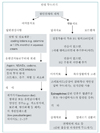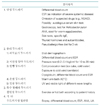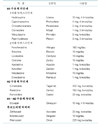Abstract
Chronic urticaria is a well-known disease entity, characterized by the rapid appearance of frequently occurring, short-lived wheals, surrounded by a bright-red flare, and often accompanied by angioedema. Any pattern of recurrent urticaria occurring at least twice a week for 6 weeks is called chronic. The cause of chronic urticaria is undefined and its diagnosis requires exclusion of other conditions with somewhat similar symptoms. Degranulation of mast cells with release of histamine is central to the development of wheals. About 26~50% of patients with idiopathic urticaria have histamine-releasing autoantibodies in their blood. Urticaria has a profound impact on the quality of life. It is essential to avoid substances likely to trigger or intensify episodes. Treatment is directed at eliminating or at least substantially reducing symptoms. The most important pharmacotherapy is non-sedating H1 antihistamines. They have proved to be effective in double-blind controlled studies. However, alternative therapies may be required because of different urticaria subtypes and individual variations. Immunosuppressive drugs such as cyclosporin A and corticosteroids should not be used as a long-term management due to undesirable side effects.
References
1. Zuberbier T, Greaves MW, Juhlin L, Kobza-Black A, Maurer D, Stingl G, et al. Definition, classification, and routine diagnosis of urticaria : A consensus report. J Investig Dermatol Symp Proc. 2001. 6:123–127.

3. Sibbald RG, Cheema AS, Lozinski A, Tarlo S. Chronic urticaria. Evaluation of the role of the physical, immunologic, and other contributory factors. Int J Dermatol. 1991. 30:381–386.
5. Sabroe RA, Greaves MW. The pathogenesis of chronic idiopathic urticaria. Arch Dermatol. 1997. 133:1003–1008.

6. Champion RH, Robert SO, Carpenter RG, Roger JH. Urticaria and angioedema. A review of 554 patients. Br J Dermatol. 1969. 81:588–597.
13. Hide M, Francis DM, Grattan CEH, Hakimi J, Kochan JP, Greaves MW. Autoantibodies against the high affinity IgE receptor as a cause of histamine release in chronic urticaria. N Engl J Med. 1993. 328:1599–1604.

14. Fiebiger E, Hammerschmid F, Stingl G, Maurer D. Anti-FcεRIα autoantibodies in autoimmune disorders. Identification of a structure-function relationship. J Clin Invest. 1998. 101:243–251.

15. Ferrer M, Kinet JP, Kaplan AP. Comparative studies of functional and binding assays for IgG anti-FcεRIα(α-subunit) in chronic urticaria. J Allergy Clin Immunol. 1998. 101:672–676.

16. Gruber BL, Baeza M, Marchese M, Agnello V, Kaplan AP. Prevalence and functional role of anti-IgE autoantibodies in urticarial syndromes. J Invest Dermatol. 1988. 90:213–217.

18. Sabroe RA, Seed PT, Francis DM, Barr RM, Black AK, Greaves MW. Chronic idiopathic urticaria: comparison of the clinical features of patients with and without anti-FcεRI or anti-IgE autoantibodies. J Am Acad Dermatol. 1999. 40:443–450.

19. Kikuchi Y, Kaplan AP. Mechanisms of autoimmune activation of basophils in chronic urticaria. J Allergy Clin Immunol. 2001. 107:1056–1062.

20. Kikuchi Y, Kaplan AP. A role for C5a in augmenting igG-dependent histamine release from basophils in chronic urticaria. J Allergy Clin Immunol. 2002. 109:114–118.

21. Leznoff A, Sussman GL. Syndrome of idiopathic chronic urticaria and angioedema with thyroid autoimmunity : a study of 90 patients. J Allergy Clin Immunol. 1989. 84:66–71.

22. Irani C, Gordon ND, Zweiman B, Levinson AI. Chronic urticaria/angioedema and Graves' disease : coexistence of 2 antireceptor antibody-mediated diseases. J Allergy Clin Immunol. 2001. 108:874.

23. Heyman WR. Chronic urticaria and angioedema associated with thyroid autoimmunity : review and therapeutic implications. J Am Acad Dermatol. 1999. 40:229–232.
24. Greaves MW. Chronic idiopathic urticaria (CIU) and Helicobacter pyroli-not directly causative but could there be a link? Allergy Clin Immunol Int. 2001. 13:23–27.
25. Beyer K, Castro R, Feidel C, Sampson HA. Milk-induced urticaria is associated with the expansion of T cells expressing cutaneous lymphocyte antige. J Allergy Clin Immunol. 2002. 109:688–693.

27. Confino-Cohen R, Aharoni D, Goldberg A, Gurevitch I, Buchs A, Weiss M, et al. Evidence for aberrant regulation of the p21Ras pathway in PBMCs of patients with chronic idiopathic urticaria. J Allergy Clin Immunol. 2002. 109:349–356.

28. Sabroe RA, Poon E, Orchard GE, Lane D, Francis DM, Barr RM, et al. Cutaneous inflammatory cell infiltrate in chronic idiopathic urticaria : comparison of patients with and without anti-Fc(RI or anti-IgE autoantibodies. J Allergy Clin Immuol. 1999. 103:484–493.

29. Ying S, Kikuchi Y, Meng Q, Kay AB, Kaplan AP. Th1/Th2 cytokines and inflammatory cells in skin biopsy specimens from patients with chronic idiopathic urticaria : comparison with the allergen-induced late phase cutaneous reaction. J Allergy Clin Immunol. 2002. 109:694–700.

31. Ortonne JP. Chronic idiopathic urticaria for the generalist. Eur J Intern Med. 2003. 14:148–157.

32. Barlow RJ, Warbuton F, Watson F, Kobza Black A, Greaves MW. Diagnosis and incidence of delayed pressure urticaria in patients with chronic urticaria. J Am Acad Dermatol. 1993. 29:954–958.

33. Pien LC. Appropriate use of second-generation antihistamines. Cleve Clin J Med. 2000. 67:372–380.

35. Andrews AW, Fornwald JA, Lijinsky W. Nitrosation and mutagenicity of some amine drugs. Toxicol Appl Pharmacol. 1980. 52:237–244.

36. Erbagci Z. The leukotriene receptor antagonist montelukast in the treatment of chronic idiopathic urticaria : a single-blind, placebo-controlled, crossover clinical study. J Allergy Clin Immunol. 2002. 110:484–488.

37. Nettis E, Dambra P, D'Oronzio L, Loria MP, Ferrannini A, Tursi A. Comparison of montelukast and fexofenadine for chronic idiopathic urticaria. Arch Dermatol. 201. 137:99–100.
38. Pacor ML, Di Lorenzo G, Corrocher R. The leukotriene receptor antagonist montelukast in the treatment of chronic idiopathic urticaria : a single-blind, placebo-controlled, crossover clinical study. Clin Exp Allergy. 2001. 31:1607–1614.

39. Grattan CEH, O'Donnell BF, Francis DM, Niimi N, Barlow RJ, Seed PT, et al. Randomized double-blind study of cyclosporine in chronic idiopathic urticaria. Br J Dermatol. 2000. 143:365–372.

40. Grattan CEH, Francis DM, Slater NGP, Barlow RJ, Greaves MW. Plasmapheresis for severe, unremitting, chronic urticaria. Lancet. 1992. 339:1078–1080.

41. O'Donnell BF, Barr RM, Kobza Black A, Francis DM, Kermani F, Niimi N, et al. Intravenous immunoglobulin in autoimmune chronic urticaria. Br J Dermatol. 1998. 138:101–106.




 PDF
PDF ePub
ePub Citation
Citation Print
Print







 XML Download
XML Download